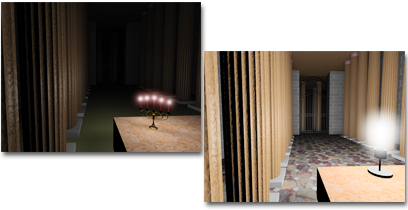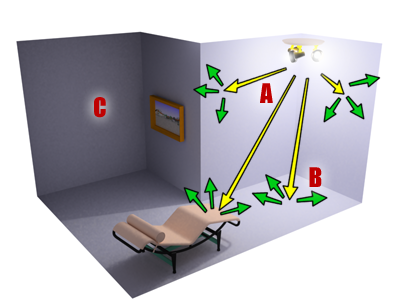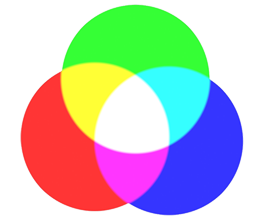This topic describes light in the real world. When you light a scene, it can be helpful to know how light naturally behaves.
When light rays strike a surface, the surface reflects them, or at least some of them, enabling us to see the surface. The appearance of a surface depends on the light that strikes it combined with the properties of the surface material, such as color, smoothness, and opacity.
Materials let you specify the visual properties of surfaces.
Intensity
The intensity of light at its point of origin affects how brightly the light illuminates an object. A dim light cast on a brightly colored object shows only dim colors.

Left: A room lit by candles, which are a low-intensity source.
Right: The same room lit by a higher-intensity light bulb.
Angle of Incidence
The more a surface inclines away from a light source, the less light it receives and the darker it appears. The angle of the surface normal relative to the light source is known as the angle of incidence.
When the angle of incidence is 0 degrees (that is, the light source strikes the surface perpendicularly), the surface is illuminated with the full intensity of the light source. As the angle of incidence increases, the intensity of illumination decreases.

Angle of incidence affects intensity.
Attenuation
In the real world, light diminishes over distance. Objects far from the light source appear darker; objects near the source appear brighter. This effect is known as attenuation.
In nature, light attenuates at an inverse square rate. That is, its intensity diminishes in proportion to the square of the distance from the light source. It is common for attenuation to be even greater when light is dispersed by the atmosphere, especially when there are dust particles in the atmosphere, or fog or clouds.

A. Inverse decay
B. Inverse square decay
The graphs show the decay curves.
Reflected Light and Ambient Light
The light an object reflects can illuminate other objects. The more light a surface reflects, the more light it contributes to illuminating other objects in its environment.
Reflected light creates ambient light. Ambient light has a uniform intensity and is uniformly diffuse. It has no discernible source and no discernible direction.

A. Direct light
B. Reflected light
C. Resulting ambient light
Color and Light
The color of light depends partly on the process that generates the light. For example, a tungsten lamp casts orange-yellow light, a mercury vapor lamp casts cold blue-white light, and sunlight is yellow-white. Light color also depends on the medium the light passes through. For example, clouds in the atmosphere tint daylight blue, and stained glass can tint light a highly saturated color.
Light colors are additive colors; the primary light colors are red, green, and blue (RGB). As multiple colored lights mix together, the total light in the scene gets lighter and eventually turns white.

Additive mixing of colored lights
Color Temperature
Color temperature describes a color in terms of degrees Kelvin (K). This is useful for describing the color of light sources and other color values that are close to white. The following table shows color temperatures for some common types of light, with the equivalent hue number (from the HSV color description).
If you use these hue numbers for lights in a scene, set the value to full (255) and then adjust the saturation to meet the needs of your scene. Mentally we tend to correct light color so that objects appear to be lit by white light; usually the effect of color temperature in a scene should be subtle.
| Light source | Color Temperature | Hue |
|---|---|---|
| Overcast daylight | 6000 K | 130 |
| Noontime sunlight | 5000 K | 58 |
| White fluorescent | 4000 K | 27 |
| Tungsten/halogen lamp | 3300 K | 20 |
| Incandescent lamp (100 to 200 W) | 2900 K | 16 |
| Incandescent lamp (25 W) | 2500 K | 12 |
| Sunlight at sunset or sunrise | 2000 K | 7 |
| Candle flame | 1750 K | 5 |